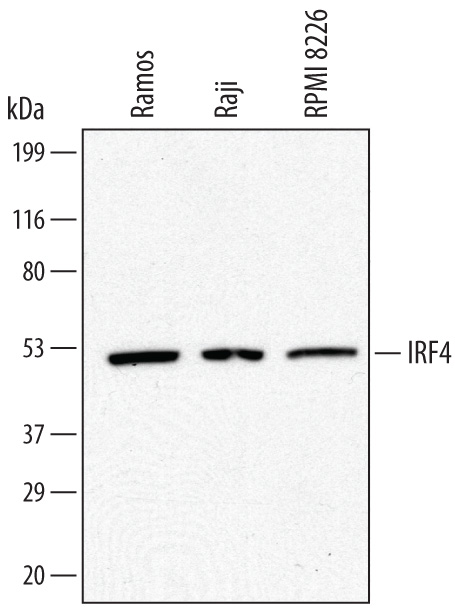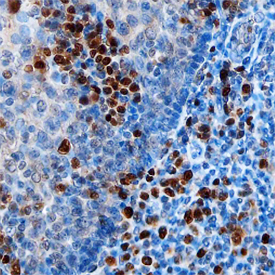Human IRF4 Antibody Summary
Glu130-Glu451
Accession # Q15306
Applications
Please Note: Optimal dilutions should be determined by each laboratory for each application. General Protocols are available in the Technical Information section on our website.
Scientific Data
 View Larger
View Larger
Detection of Human IRF4 by Western Blot. Western blot shows lysates of Ramos human Burkitt's lymphoma cell line, Raji human Burkitt's lymphoma cell line, and RPMI 8226 human multiple myeloma cell line. PVDF membrane was probed with 0.5 µg/mL of Sheep Anti-Human IRF4 Antigen Affinity-purified Polyclonal Antibody (Catalog # AF5525) followed by HRP-conjugated Anti-Sheep IgG Secondary Antibody (Catalog # HAF016). A specific band was detected for IRF4 at approximately 53 kDa (as indicated). This experiment was conducted under reducing conditions and using Immunoblot Buffer Group 1.
 View Larger
View Larger
IRF4 in Human Tonsil. IRF4 was detected in immersion fixed paraffin-embedded sections of human tonsil using Sheep Anti-Human IRF4 Antigen Affinity-purified Polyclonal Antibody (Catalog # AF5525) at 3 µg/mL overnight at 4 °C. Before incubation with the primary antibody, tissue was subjected to heat-induced epitope retrieval using Antigen Retrieval Reagent-Basic (Catalog # CTS013). Tissue was stained using the Anti-Sheep HRP-DAB Cell & Tissue Staining Kit (brown; Catalog # CTS019) and counterstained with hematoxylin (blue). Specific staining was localized to cytoplasm of lymphocytes. View our protocol for Chromogenic IHC Staining of Paraffin-embedded Tissue Sections.
Reconstitution Calculator
Preparation and Storage
- 12 months from date of receipt, -20 to -70 °C as supplied.
- 1 month, 2 to 8 °C under sterile conditions after reconstitution.
- 6 months, -20 to -70 °C under sterile conditions after reconstitution.
Background: IRF4
Interferon regulatory factor 4 (IRF4), also known as MUM1 and LSIRF, is a 51 kDa lymphocyte-restricted transcription factor. It is required for immunoglobulin class switching and terminal differentiation of B cells. IRF4 is overexpressed in multiple myeloma and cooperates with Myc in an autoregulatory loop. In T cells, IRF4 is required for the production of IL-4. IRF4 contains an N-terminal DNA binding domain that is homologous to that in other IRF proteins. Within the C-terminal domain (aa 130‑451), human IRF4 shares 90% aa sequence identity with mouse and rat IRF4. Alternate splicing may generate isoforms with N-terminal, C-terminal, or internal deletions.
Product Datasheets
Citation for Human IRF4 Antibody
R&D Systems personnel manually curate a database that contains references using R&D Systems products. The data collected includes not only links to publications in PubMed, but also provides information about sample types, species, and experimental conditions.
1 Citation: Showing 1 - 1
-
Activin-A co-opts IRF4 and AhR signaling to induce human regulatory T cells that restrain asthmatic responses
Authors: S Tousa, M Semitekolo, I Morianos, A Banos, AI Trochoutso, TM Brodie, N Poulos, K Samitas, M Kapasa, D Konstantop, G Paraskevop, M Gaga, CM Hawrylowic, F Sallusto, G Xanthou
Proc. Natl. Acad. Sci. U.S.A, 2017-03-20;0(0):.
Species: Human
Sample Types: Whole Cells
Applications: ICC
FAQs
No product specific FAQs exist for this product, however you may
View all Antibody FAQsReviews for Human IRF4 Antibody
There are currently no reviews for this product. Be the first to review Human IRF4 Antibody and earn rewards!
Have you used Human IRF4 Antibody?
Submit a review and receive an Amazon gift card.
$25/€18/£15/$25CAN/¥75 Yuan/¥2500 Yen for a review with an image
$10/€7/£6/$10 CAD/¥70 Yuan/¥1110 Yen for a review without an image



